So-So-So and no Tika. What is the difference between Intel Core processors of different generations based on the same architecture?
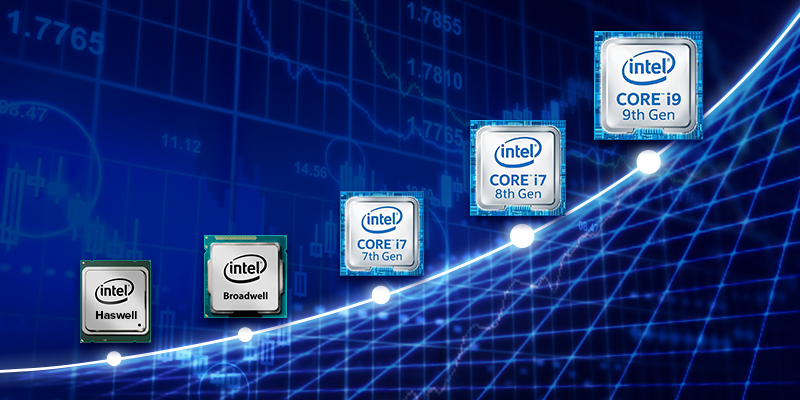
With the advent of the seventh generation Intel Core processors, it became clear to many that the “Tick-Tack” strategy, which Intel had followed all this time, failed. The promise to reduce the process from 14 to 10 nm remains a promise, the long era of “Taka” Skylake began, during which Kaby Lake (the seventh generation) happened, and the sudden Coffee Lake (eighth) with a slight change in the process from 14 nm to 14 nm and even Coffee Lake Refresh (ninth). It seems Intel really needed a short coffee break. As a result, we have several processors of different generations, which are based on the same Skylake micro-architecture, on the one hand. And Intel’s assurances that each new processor is better than before, on the other. True, it is not very clear what exactly ...

')
So back to our generations. And let's see how they differ.
Kaby lake
The appearance of processors in retail took place in early 2017. What is new about this family regarding its predecessor? First of all, this is a new graphics core - Intel UHD 630. Plus, support for Intel Optane memory technology (3D Xpoint), as well as a new 200th series chipset (the 6th generation worked with the 100th series). And on this of all the really interesting innovations.
Coffee lake
The 8th generation, codenamed Coffee Lake, was released at the end of 2017. In the processors of this generation, they added cores and in proportion to the third-level cache, raised Turbo Boost by 200 megahertz, added support for DDR4-2666 (previously it was DDR4-2400), but cut off support for DDR3. The graphics core remains the same, but it is thrown 50 MHz. For all the frequency increases had to pay an increase in heat pack up to 95 watts. And, of course, the new 300th series chipset. The latter was not at all necessary, as soon as the specialists were able to launch this family on the chipsets of the 100th series, although Intel representatives stated that this was impossible due to the peculiarities of building the power supply circuits. Later, however, Intel officially acknowledged that he was wrong. So what's new in the 8th family? In fact, it looks more like a normal refresh with the addition of cores and frequencies.
Coffee Lake Refresh
Ha! But to us and refresh! In the fourth quarter of 2018, the Coffee Lake 9th generation processors were released, equipped with hardware protection against some Meltdown / Specter vulnerabilities. Hardware changes made to the new chips protect against Meltdown V3 and L1 Terminal Fault (L1TF Foreshadow). Changes in software and microcode protect against Specter V2, Meltdown V3a and V4 attacks. Protection against Specter V1 will continue to be patched at the operating system level. The appearance of patches at the chip level should reduce the impact of software patches on processor performance. But Intel realized all this joy with protections only in processors for the mass market segment: i5-9600k, i7-9700k, i9-9900k. All the rest, including server solutions, did not sprinkle hardware protection. For the first time in the history of Intel consumer processors, Coffee Lake Refresh processors support up to 128 GB of RAM. And that's all, no more changes.
What do we have in the bottom line? Two years refresh, games with cores and frequencies, plus a set of small improvements. I really wanted to objectively evaluate and compare the performance of the main representatives of these families. Therefore, when I had the kit from the seventh to the ninth generation at hand - to our i7-7700 and i7-7700k I recently added fresh i7-8700, i7-9700k and i9-9900k, I took advantage of the situation and made five different processors of Intel Core show what they are capable of.
Testing
The test involved five Intel processors: i7-7700, i7-7700k, i7-8700, i7-9700k, i9-9900k.
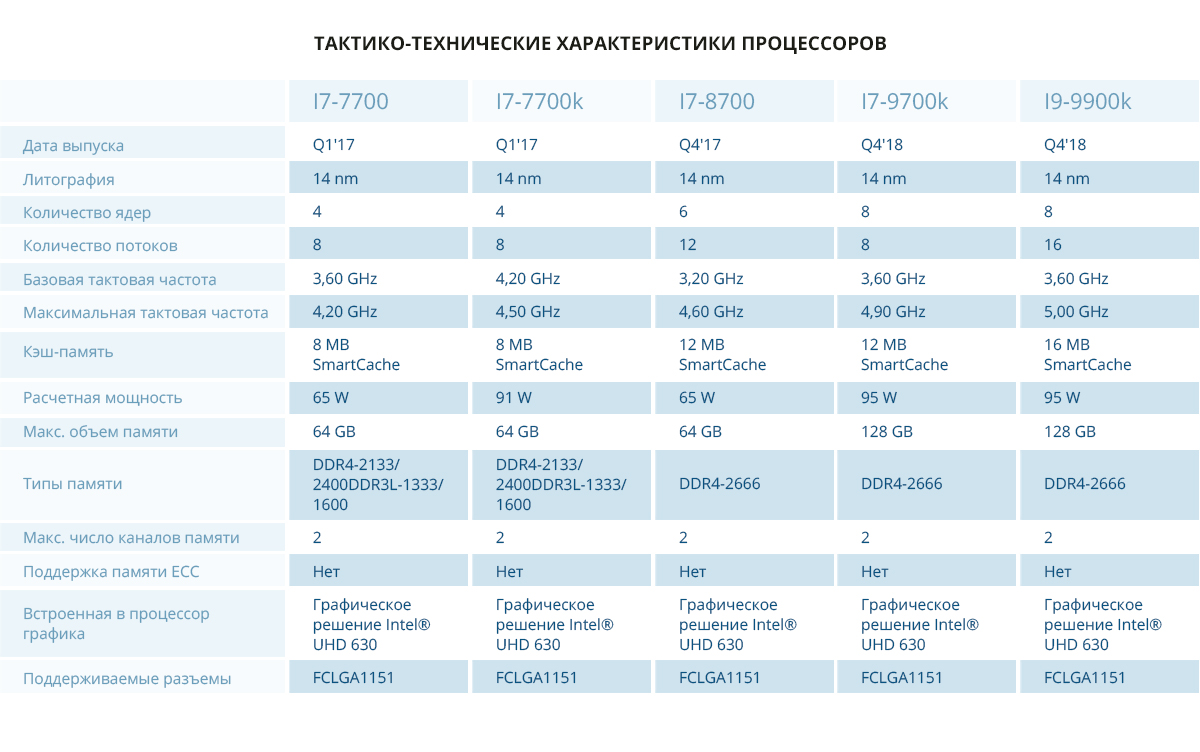
Performance characteristics of platforms
Intel i7-8700, i7-9700k and i9-9900k processors have the same basic configuration:
- Motherboard: Asus PRIME H310T (BIOS 1405),
- RAM: 16 GB DDR4-2400 MT / s Kingston 2 pieces, total 32 GB.
- SSD: 240 GB Patriot Burst 2 pieces in RAID 1 (a habit developed over the years).
The Intel i7-7700 and i7-7700k processors also run on the same platform:
- Motherboard: Asus H110T (BIOS 3805),
- RAM: 8 GB DDR4-2400MT / s Kingston 2 pieces, a total of 16 GB.
- SSD: 240 GB Patriot Burst 2 pieces in RAID 1.
We use custom-built 1.5-unit chassis. They accommodate four platforms.
Software: OS CentOS Linux 7 x86_64 (7.6.1810).
Kernel: 3.10.0-957.1.3.el7.x86_64
The optimizations made relative to the standard installation: the kernel launch options have been added elevator = noop selinux = 0.
Testing is done with all Specter, Meltdown, and Foreshadow patches that are backported to this core. It is possible that the test results on newer and more current Linux kernels may differ from those obtained, and the performance will be better. But, first of all, CentOS 7 is nicer to me personally, and, secondly, RedHat is actively engaged in backporting innovations related to hardware support from new cores to its own, LTS. That's what I hope :-)
Tests that are used for research
- Sysbench
- Geekbench
- Phoronix Test Suite
Sysbench test
Sysbench - a test suite (or benchmarks) for evaluating the performance of different computer subsystems: a processor, RAM, data storage devices. Multi-threaded test for all cores. In this test, I measured two indicators:
- CPU speed events per second - the number of operations performed by the processor per second: the higher the value, the more productive the system.
- General statistics total number of events - the total number of events executed. The higher the better.
Geekbench test
Package tests conducted in single-threaded and multi-threaded mode. As a result, a certain performance index is issued for both modes. Below are links to test results. In this test, we will look at two key indicators:
- Single-Core Score - single-flow tests.
- Multi-Core Score - multi-threaded tests.
Units of measure: abstract "parrots". The more “parrots”, the better.
Phoronix Test Suite
Phoronix Test Suite is a very rich test suite. Despite the fact that all the tests from the pts / cpu package were conducted, I’ll give the results of those that I personally found particularly interesting, especially since the results of the missed tests only reinforce the general trend.
Almost all the tests presented here are multi-threaded. The only exceptions are two of them: single-threaded tests Himeno and LAME MP3 Encoding.
In these tests, the higher the score, the better.
- John the Ripper multi-threaded password test. Take the Blowfish cryptographic algorithm. Measures the number of operations per second.
- The Himeno test is a Poisson linear pressure solver using the Jacobi point method.
- 7-Zip Compression - 7-Zip test using p7zip with an integrated performance test feature.
- OpenSSL is a set of tools that implement the SSL (Secure Sockets Layer) and TLS (Transport Layer Security) protocols. Measures the performance of RSA 4096-bit OpenSSL.
- Apache Benchmark - the test measures how many requests per second a given system can withstand when executing 1,000,000 requests, with 100 requests being executed simultaneously.
And in these if less, it is better
- C-Ray tests CPU performance on floating-point calculations. This test is multi-threaded (16 threads per core), will shoot 8 rays from each pixel for smoothing and generate an image of 1600x1200. Measured test time.
- Parallel BZIP2 Compression - The test measures the time required to compress a file (the .tar package of the Linux kernel source) using BZIP2 compression.
- Encoding audio and video data. The LAME MP3 Encoding test runs as one stream, and the ffmpeg x264 test is multi-threaded. Measured test time.
As you can see, the test suite consists of purely synthetic tests that show the difference between processors when performing certain tasks, for example, clicking passwords, encoding media content, and cryptography.
A synthetic test, unlike a test that is conducted under conditions close to reality, is capable of providing a certain purity of the experiment. Actually, therefore, the choice fell on synthetics.
It is not excluded that while solving private tasks in combat conditions you will be able to get extremely interesting and unexpected results, but still the “general temperature in the hospital” will be as close as possible to what I got from the test results. It is also possible that by disabling the Specter / Meltdown protection when testing the 9th generation processors, I could get better results. But, looking ahead, I will say - they have already shown themselves so well.
Spoiler: core, streams and frequencies will rule the ball.
Even before testing, I carefully studied the architecture of the families of these processors, so I expected that there would be no significant differences between the experimental ones. Moreover, not so much significant as extraordinary: why wait for interesting indicators in tests, if you take measurements on processors, built, in essence, on one core. My expectations were met, but something still turned out to be not quite as I thought ...
And now, in fact, the test results.
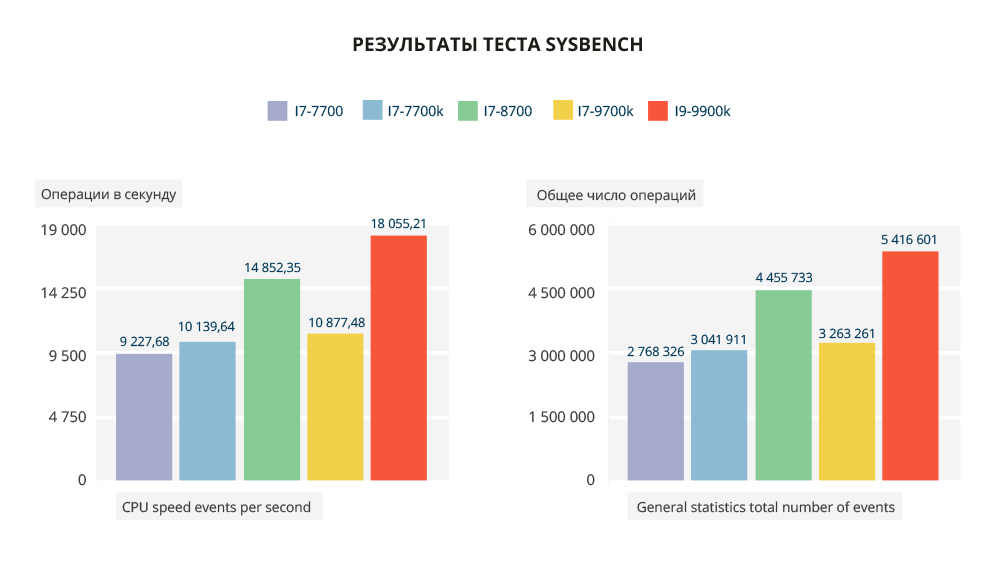
The result is quite natural: who has more streams and higher frequency, moreover, and points. Accordingly, i7-8700 and i9-9900k ahead. The gap between i7-7700 and i7-7700k is 10% in a single-threaded and multi-threaded test. The i7-7700 lags behind the i7-8700 by 38% and from the i9-9900k by 49%, that is, almost 2 times, but the lag from the i7-9700k is only 15%.

Links to test results:
Intel i7-7700
Intel i7-7700k
Intel i7-8700
Intel i7-9700k
Intel i9-9900k
Test results from The Phoronix Test Suite
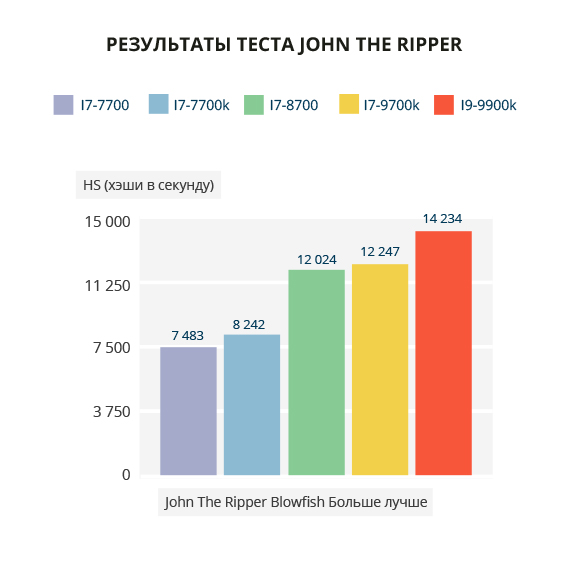
In the John The Ripper test, the difference between the twin brothers i7-7700 and i7-7700k is 10% in favor of the "k", due to the difference in Turbobust. For i7-8700 and i7-9700k processors, the difference is very small. i9-9900k overtakes all at the expense of a larger number of threads and a higher clock frequency. Twins almost 2 times.

The result of the C-Ray test seems to me the most interesting. The presence of Hyper-Treading technology in the i9-9900k in this multi-threaded test gives only a slight increase relative to the i7-9700k. But the twins are almost 2 times behind the leader.

In the Himeno single-threaded test, the difference is not so great. The tangible lead of the 8th and 9th generation from the twins: i9-9900k outruns them by 18% and 15%, respectively. The difference between the i7-8700 and i7-9700k at the level of error.
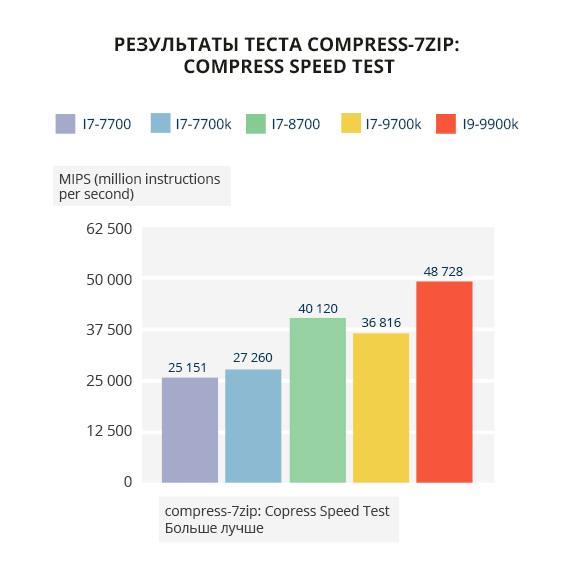
The 7zip compression test for twins is 44-48% worse than the i9-9900k leader. Due to the greater number of streams, i7-8700 overtakes i7-9700k by 9%. But this is not enough to overtake the i9-9900k, so we are seeing a lag of almost 18%.

The test for compression time using the BZIP2 algorithm shows similar results: the streams win.
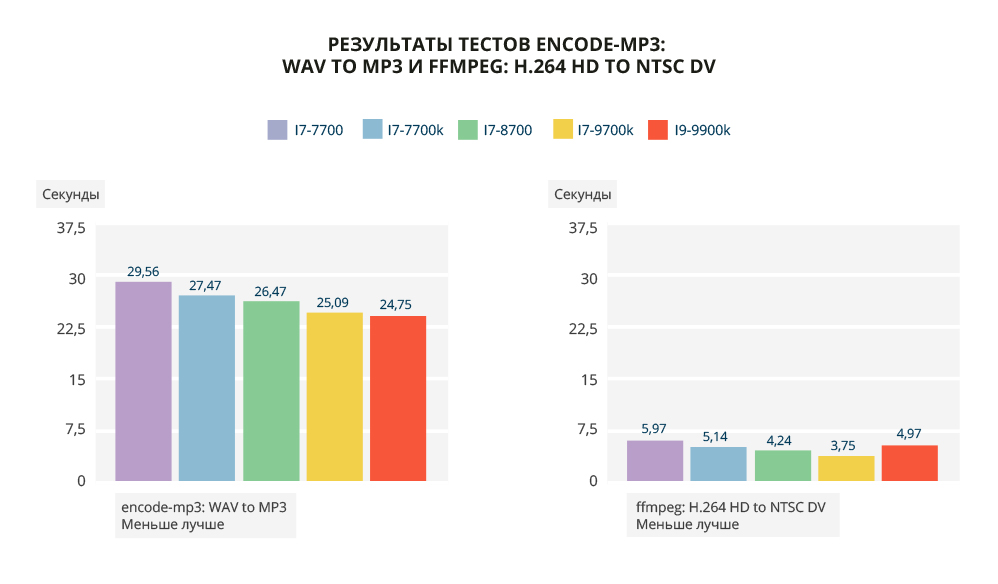
MP3 encoding is a “ladder” with a maximum margin of 19.5%. But in the ffmpeg test, the i9-9900k loses the i7-8700 and i7-9700k, but bypasses the twins. I redid this test several times for i9-9900k, but the result is always the same. Now this is unexpected :-) In the multi-threaded test, the most multi-threaded of the tested processors showed such a low result, lower than that of 9700k and 8700. There is no clear explanation for this phenomenon, but I don’t want to make any assumptions.

The openssl test shows a “ladder” with a gap between the second and third steps. The difference between the twins and the leader i9-9900k from 42% to 47%. The gap between i7-8700 and i9-9900k is 14%. The main thing is the flow and frequency.

In the Apache test, i7-9700k outperformed everyone, including the i9-9900k (6%). But in general, the difference is not significant, although between the worst result of i7-7700 and the best among i7-9700k the gap is 24%.

In general, i9-9900k leads the way in most tests, failing only on ffmpeg. If you are going to work with video, take better i7-9700k or i7-8700. In the second place overall i7-9700k, it is slightly behind the leader, and in the ffmpeg and apache tests it is even ahead. So his and i9-9900k feel free to advise those who regularly have large influxes of users on the site. Processors should not fail. I already said about the video.
The i7-8700 has good Sysbench, 7zip and ffmpeg tests.
In all tests, i7-7700k is better than i7-7700 from 2% to 14%, in the ffmpeg test, 16%.
Let me remind you that I didn’t do any optimization, except for those mentioned at the beginning, which means that when you install a clean system on a freshly purchased Dedik, you will get exactly the same results.
Kernels, streams, frequencies - our everything
Overall, the results were predictable and expected. Practically in all tests, a “ladder to the sky” appears, demonstrating the dependence of performance on the number of cores, streams and frequencies: more of this all, better results.
Since all the subjects actually are refreshing the same core on the same process technology and do not have any fundamental architectural differences, we could not get “stunning” evidence that the processors are qualitatively different from each other.
The difference between the i7-9700k and i9-9900k processors in all tests, except Sysbench, tends to zero, since in fact they differ only in the presence of Hyper-Threading technology and hundreds of additional megahertz in the Turbo Boost mode in i9-9900k. In the Sysbench test, the opposite is true: it is not the number of cores that decides, but the number of threads.
There is a very large gap in multi-threaded tests between i7-7700 (k) and i9-9900k, sometimes twice as much. There is also a difference between the i7-7700 and the i7-7700k - the extra 300 MHz adds quickness to the latter.
Also, I can’t talk about the qualitative influence of the amount of cache memory on test results - we have what we have. Moreover, the included protection of the Specter / Meltdown family should considerably reduce the impact of its volume on the test results, but this is not accurate. If a dear reader demands “bread and circuses” from our marketing department, I’ll be happy to download testing with disabled protection for you.
Actually, if I was asked: which processor would you choose? - I would start by counting the money in my pocket, and I chose the one that was enough. In short, from point A to point B you can get on the Zhiguli, but the Mercedes is still faster and more pleasant. Processors based on the same architecture will in one way or another cope with the same range of tasks - someone is just fine, but someone is excellent. Yes, as shown by testing, there are no global differences between them. But the gap between i7 and i9 has not gone away.
When choosing a processor for some private highly specialized tasks, like working with mp3, compiling from source or rendering three-dimensional scenes with light processing, it makes sense to focus on the indicators of the corresponding tests. For example, designers can immediately look at the i7-9700k and i9-9900k, and for complex calculations you can take a processor with Hyper-Threading technology, that is, anyone except the i7-9700k. Here they rule streams.
So I advise you to choose what you can afford taking into account the specification, and you will be happy.
In testing, servers based on i7-7700, i7-7700k, i7-8700k, i7-9700k and i9-9900k with 1dedic.ru were used . Any of them can be ordered at a 5% discount for 3 months - contact the sales department with the code phrase "I am with Habr." If you pay for the year minus another 10%.
All evening in the arena of Trashwind , FirstDEDIC system administrator
Source: https://habr.com/ru/post/443650/
All Articles